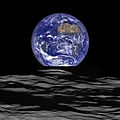English: The Earth straddling the limb of the Moon, as seen from
Lunar Reconnaissance Orbiter above
Compton crater. The shadow in the foreground is from the crater's
central peaks, while the mountains just above it can be seen in the 10 o'clock position within the crater in
this image or the 12 o'clock position in
this image. The center of the Earth in this view is 4.04°N, 12.44°W, just off the coast of Liberia. The large tan area in the upper right is the Sahara desert, and just beyond is Saudia Arabia. The Atlantic and Pacific coasts of South America are visible to the left.
From the Earth, the daily Moonrise and Moonset are always inspiring moments. However, lunar astronauts will see something very different: viewed from the lunar surface, the Earth never rises or sets. Since the Moon is tidally locked, the Earth is always in the same spot above the horizon, varying only a small amount with the slight wobble of the Moon. The Earth may not move across the "sky", but the view is not static. Future astronauts will see the continents rotate in and out of view and the ever changing pattern of clouds will always catch one's eye. Well at least on the nearside, but what about the farside? The Earth is never visible from the farside, imagine a sky with no Earth or Moon - what will farside explorers think with no Earth overhead?
This image was taken when LRO was 134 km above the farside crater Compton (51.8°N, 124.1°E). Capturing an image of the Earth and Moon with LROC is a complicated task. First the spacecraft must be rolled to the side (in this case 67°), then the spacecraft slews with the direction of travel to maximize the width of the lunar horizon in the NAC image. All this takes place while LRO is traveling over 1600 meters per second (faster than 3580 mph) relative to the lunar surface below the spacecraft! As a result of these three motions and the fact that the Narrow Angle Camera is a line scanner the raw image geometry is distorted. Also, because the Moon and Earth are so far apart, the geometric correction is different for each body. Reconstruction of the Earth-Moon image is not a simple matter – and that is just to get the black and white image!
What about color? The WAC images the same scene repeatedly while the NAC scans across the scene just once. Since the NAC pixel scale is 75 times smaller than the WAC pixel scale, a straight Earth and Moon composite would show a very fuzzy Earth and a sharp Moon. The LROC team took advantage of the multiple WAC images of the Earth to create a sharpened WAC Earth. For each WAC pixel the Earth was imaged between 20 and 50 times (the WAC FOV moved only a small fraction of a pixel between each image), and these multiple looks were combined (for the Earth only, the Moon as shown is NAC). The colors are only approximately what an intrepid explorer would see from the Moon because the human eye is fully sensitive to all colors across the visible wavelength range, whereas the WAC sees through a set of narrow band filters (the view here combines the 604 nm (orange), 556 nm (yellow-green), and 415 nm (violet) bands displayed in red, green, and blue, respectively).
The Earth is much brighter (higher reflectance) than the Moon, especially from this angle; the Earth was captured near noon while the limb of the Moon was just appearing from the shadows of night, so the Moon was relatively dim. In the opening image the Moon and Earth were contrast-stretched separately to bring out details on the lunar surface. The two contrast stretch makes for a spectacular image, but it may be misleading in a purely scientific sense.
The sharp black outline across the bottom of the Earth is from mountains still on the night side of the lunar terminator.
A blog post by Emily Lakdawalla discusses the creation of this image.
The original NASA image was converted from TIFF to JPEG format by the uploader.






